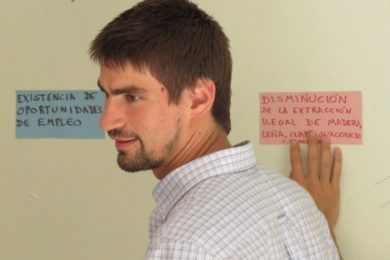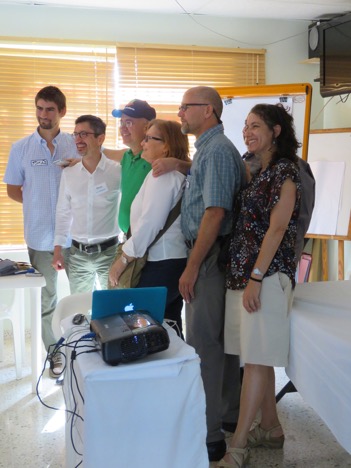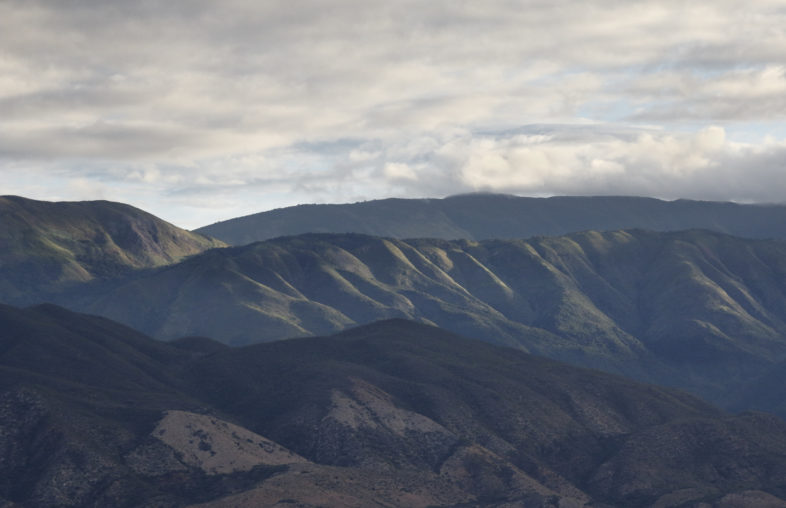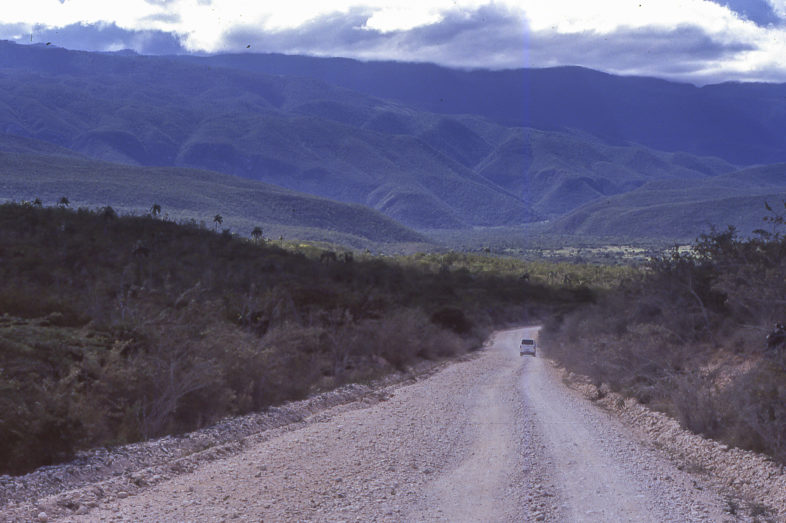The Sierra de Bahoruco rises from arid plains in the far southwest of the Dominican Republic. Part of a long limestone massif that stretches into neighboring Haiti, the mountains create an imposing east-west barrier, reaching nearly 8,000 feet in elevation. As currents of air hit the range they rise and cool, forming clouds that drop copious amounts of rain – often in excess of 6 feet – on the higher slopes. The steep elevational gradient in rainfall produces a pronounced ecological pattern in forest type. At the lowest elevations, rainfall is scarce and dry flats of thorn scrub dominate. At about 1,300 feet above sea level, dry scrub gives way to dry tropical forests dominated by mahogany, gumbo limbo, and other hardwoods. Wet broadleaf forest – the winter home of Bicknell’s Thrush – covers the mountain slopes at elevations between 3,000 and 6,000 feet, finally yielding to extensive forests of the endemic Hispaniolan pine on the highest, coldest slopes.
The diversity of habitats offered by different forest types, coupled with the action of evolution at work in these isolated sky islands, has given rise to extraordinary levels of biodiversity. In addition to providing a home for many migratory birds from North America, Sierra de Bahoruco is critical habitat for threatened endemic birds such as La Selle Thrush and Western Chat-Tanager. Sierra de Bahoruco is also home to numerous species of frogs, orchids, and other plants that occur only in these mountains. The ecosystems of Sierra de Bahoruco are important for people, too; they provide critical services to the human communities that fringe the lower elevations, most notably the stable provision of clean water. In recognition of the importance of Sierra de Bahoruco, the government of the Dominican Republic established a large protected area, Sierra de Bahoruco National Park, to allow for the conservation of biodiversity and critical ecosystem services.
Despite the good intention behind the establishment of the park, most now agree that it is failing to serve its purpose. Without adequate resources for law enforcement and with mixed support from local communities, the integrity of the park is threatened. Illegal forest clearing for large- and small-scale agriculture has chipped away at much of the park: slash-and-burn agriculture has eliminated large areas of dry forest at lower elevations, and industrial avocado production – mostly for export to European markets – continues to destroy and fragment broadleaf forest at higher elevations. Human-ignited fires, exacerbated by climate change that favors extended periods of drought, frequently sweep uncontrolled through the pinelands. Illegal collection and harvest of plants and animals, for example parrots and iguanas for the pet trade and removal of trees for charcoal production and the collection of essential oils, threaten populations of many species.

Chilean facilitator Tomas Saratscheff getting to the heart of the problem facing Sierra de Bahoruco: how to reconcile the need for local livelihoods with the health and integrity of its forests.
An important effort to address these threats and ensure a healthy future for the park is underway. With funding from a US Fish and Wildlife Service Neotropical Migratory Bird Conservation Act grant, VCE is supporting the creation of a strategic conservation plan for Sierra de Bahoruco. Organized in collaboration with our local partner, Grupo Jaragua, and the Dominican Republic’s Ministry of the Environment and Natural Resources, we are hosting workshops in the two primary towns bordering the park, Pedernales and Duvergè. The workshops, each lasting 3 days, are facilitated by four conservation biologists: Oscar Maldonado from Guatemala, Tomas Saratscheff from Chile, Grupo Jaragua’s Andrea Thomen, and VCE Research Associate Jim Goetz, each trained in the Open Standards process for crafting conservation plans. The process is participative, with community members, government officials, and scientists working together to identify the most pressing threats and to develop strategies to eliminate them.
As an observer at the workshops, I have been impressed by the collaborations emerging among stakeholders with apparently different interests. Although many of the strategies revolve around enforcement of existing laws and regulations, sustainable development that creates new employment opportunities has also emerged as an important strategy uniting the interests of community members and conservationists alike. If people can come to see the park not only as a source of clean water but also as an opportunity to improve livelihoods, then with time they may come to see its protection as an act of self-interest.

From left to right: facilitators Tomas Saratscheff and Oscar Maldonado; Minister of the Environment Francisco Dominguez-Brito, Grupo Jaragua Executive Director Yvonne Arias, VCE Research Associate Jim Goetz, and Grupo Jaragua’s Yoli Leon join together to kick-off the strategic conservation planning workshop for Sierra de Bahoruco.
Of course, a plan is only as useful as the actions it inspires. Time will tell whether the strategic conservation plan for Sierra de Bahoruco leads to meaningful changes that protect this beautiful landscape and its stunning biodiversity. Previous plans have been drafted and shelved without any action. If this plan is to be any different, government ministries will have to redouble their efforts at protection and sustainable development, non-governmental organizations – including VCE – will have to work together to make the most efficient use of limited resources, and local communities will have to embrace a new way of thinking about the value of the forests that surround them. These workshops have required hard work by everyone involved, facilitators and participants alike, but the demands of these 6 days will pale in comparison to the hard work needed to realize the opportunity presented by our time together.


